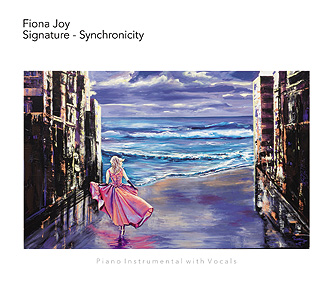 World
renowned as a piano virtuoso and music composer, Fiona Joy released
Signature – Synchronicity in 2016. In 2015, Fiona
released Signature – Solo and its follow up, Signature
– Synchronicity takes her music to a whole new level of sonic
excellence. Taking the solo piano music of Signature – Solo
and reproducing it with number of musicians, the results make
Signature – Synchronicity Fiona’s most exhilarating
album to date. Commenting on the differences between the two albums,
Fiona tells mwe3.com, “I took the same 10 songs and recorded
them on a hand made contemporary Australian piano with 97 keys in
an edited, overdubbed studio environment with full orchestration.
Totally different worlds! I added lyrics, many layers of instrumentation
and yet the piano parts are identical almost note for note, taking
the keyboard length variations into account. I wanted the listener
to see how different each approach can be.” The approach may
be different but the music sparkles in a new and different setting.
The production work of Will Ackerman, Tom Eaton and
James Englund adds to the sonic experience. Recorded in both
Australia and the U.S., Signature – Synchronicity also
benefits thanks to the added input from key musicians such as Tony
Levin (NS bass), Marc Shulman (electric guitar), Will
Ackerman (guitar), Tom Eaton (keyboard pads) Jeff Oster
(flugelhorn), Borbala Bodonyi (backing vocals), Nick
Hawkins (beat box), Jeff Haynes (percussion), Eugene
Friesen (cello) Rebecca Daniel (violin) and others. While
the basic piano themes of Signature – Synchronicity were
first explored on the Signature – Solo album, the music
gets a new shine on these newly recorded versions—proving that
great music can work in any production setting. An ethereal and captivating
listening experience flowing with lush melodies and exquisite production
techniques, Signature – Synchronicity is Fiona Joy’s
most celestial-sounding music yet.
World
renowned as a piano virtuoso and music composer, Fiona Joy released
Signature – Synchronicity in 2016. In 2015, Fiona
released Signature – Solo and its follow up, Signature
– Synchronicity takes her music to a whole new level of sonic
excellence. Taking the solo piano music of Signature – Solo
and reproducing it with number of musicians, the results make
Signature – Synchronicity Fiona’s most exhilarating
album to date. Commenting on the differences between the two albums,
Fiona tells mwe3.com, “I took the same 10 songs and recorded
them on a hand made contemporary Australian piano with 97 keys in
an edited, overdubbed studio environment with full orchestration.
Totally different worlds! I added lyrics, many layers of instrumentation
and yet the piano parts are identical almost note for note, taking
the keyboard length variations into account. I wanted the listener
to see how different each approach can be.” The approach may
be different but the music sparkles in a new and different setting.
The production work of Will Ackerman, Tom Eaton and
James Englund adds to the sonic experience. Recorded in both
Australia and the U.S., Signature – Synchronicity also
benefits thanks to the added input from key musicians such as Tony
Levin (NS bass), Marc Shulman (electric guitar), Will
Ackerman (guitar), Tom Eaton (keyboard pads) Jeff Oster
(flugelhorn), Borbala Bodonyi (backing vocals), Nick
Hawkins (beat box), Jeff Haynes (percussion), Eugene
Friesen (cello) Rebecca Daniel (violin) and others. While
the basic piano themes of Signature – Synchronicity were
first explored on the Signature – Solo album, the music
gets a new shine on these newly recorded versions—proving that
great music can work in any production setting. An ethereal and captivating
listening experience flowing with lush melodies and exquisite production
techniques, Signature – Synchronicity is Fiona Joy’s
most celestial-sounding music yet.
mwe3.com
presents an interview with
FIONA JOY
 mwe3:
You told mwe3.com that your 2015 album Signature Solo would
soon be followed by Signature Synchronicity, which is now your
2016 CD. How did one album grow out of the other and how would you
compare the two? It seems like it’s one of the rarer things to
happen in music, (to have 2 different versions of an album) although
I think The Beatles did it on Let It Be, which they did many
years later with Let It Be Naked. (maybe the Naked part came
first in the case of Signature Solo) You also described both
Signature Synchronicity and Signature Solo as being
in two different worlds. Can you elaborate on that concept as it applies
to how you approached both albums?
mwe3:
You told mwe3.com that your 2015 album Signature Solo would
soon be followed by Signature Synchronicity, which is now your
2016 CD. How did one album grow out of the other and how would you
compare the two? It seems like it’s one of the rarer things to
happen in music, (to have 2 different versions of an album) although
I think The Beatles did it on Let It Be, which they did many
years later with Let It Be Naked. (maybe the Naked part came
first in the case of Signature Solo) You also described both
Signature Synchronicity and Signature Solo as being
in two different worlds. Can you elaborate on that concept as it applies
to how you approached both albums?
Fiona Joy: Hi Robert and thanks for this opportunity to talk
about my fascination with different worlds and my recent two part
Signature Series.
Signature Solo was played on an 85 key 1885 Steinway –
solo piano recorded in single takes. I guess you are right about the
naked part – totally revealing!
I then took the same 10 songs and recorded them on a hand made contemporary
Australian piano with 97 keys in an edited, overdubbed studio environment
with full orchestration. Totally different worlds! I added lyrics,
many layers of instrumentation and yet the piano parts are identical
almost note for note, taking the keyboard length variations into account.
I wanted to the listener to see how different each approach can be.
I'm fascinated that the same songs, with the same meaning and played
the same way can sound so different. To my mind, one is just a fully
realized version of the other. I have other people telling me which
is their favorite, but I can’t pick because to me they are part
of the same body of work.
mwe3: What was your primary piano on Signature Synchronicity?
You played the 1885 Steinway on Signature Solo, so did
you find a similar sounding Steinway for Signature Synchronicity?
Were the pianos mic-ed the same way even though both albums feature
different engineers?
Fiona Joy: The pianos were also worlds apart. Going from an
1885 Steinway with 85 keys to a modern hand made Stuart & Sons
- Aussie made - with 97 keys was a massive difference. I even had
to slightly alter a few notes to accommodate the shorter/longer keyboard!
I used all 97 keys in Signature Synchronicity. The very top
and bottom notes are what I call ‘color’ – almost unable
to tune within an audible scale – but roughly in the vicinity
of the chords. The very highest notes are like glass and the deepest
give off a lot of sympathetic reverberation and require precise pedaling
so as not to carry dark undertones across your chords.
The Stuart requires good pedaling techniques. No doubt the Steinway
is easier to play and much more forgiving, but that was negated by
the recording technique to get each piece in a single take! That’s
tricky – and no headphones or auto-tune... I did sing in one
song on Signature Solo.
 mwe3:
You can hear the other instruments come into to focus on track two
“Grace” which has been played a couple different times already.
Is the Signature Synchronicity version of “Grace”
the definitive version? Who is playing with you on the Signature
Synchronicity version of “Grace”? You had said there
was also a vocal version of “Grace” and one with your son
Nick on it, which you described as a “chill” or “beat
box” version.
mwe3:
You can hear the other instruments come into to focus on track two
“Grace” which has been played a couple different times already.
Is the Signature Synchronicity version of “Grace”
the definitive version? Who is playing with you on the Signature
Synchronicity version of “Grace”? You had said there
was also a vocal version of “Grace” and one with your son
Nick on it, which you described as a “chill” or “beat
box” version.
Fiona Joy: To me the definitive “Grace’” is
just the piano part. It’s been on a Grammy winning album (Winds
of Samsara) by Wouter Kellerman and Ricky Kej, on a flute album
by Sherry Finzer, my own solo piano version and the two versions both
with lyrics on Signature Synchronicity. Track two is slower
and more acoustic because the Track 7 version is chilled out with
beat box and is played on a keyboard.
I have many musicians on the Synchronicity album. I sing the
main vocal on both versions and on the slower version is Eugene Friesen
on cello, Jeff Oster on Flugelhorn, Borbala Bodonyi with backing vocals,
Tony Levin on NS bass and Rebecca Daniel on violin.
On the ‘Chilled’ version there is the addition of beat-box
by my son Nick Hawkins, percussion with Jeff Haynes, electric Guitar
by Marc Shulman and electric bass by Tony Levin.
I have two totally different videos to show the different takes on
Grace:
https://youtu.be/iqkgLhRThIE
https://youtu.be/OcirPxyQnkM
mwe3: The Signature Synchronicity version of “Fair
Not” features several other musicians adding in some additional
haunting sounding instruments including guitars. Who is performing
with you on this new version of “Fair Not”?
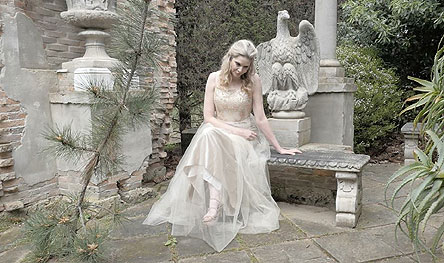 Fiona
Joy: It's quite a grand production and very dramatic! I just released
a video which is inspired by my fascination with A Game of Thrones
– we painted a dragon on a piano, set it on fire and then burned
it to the ground. I got to wear a princess dress – it was awesome
fun.
Fiona
Joy: It's quite a grand production and very dramatic! I just released
a video which is inspired by my fascination with A Game of Thrones
– we painted a dragon on a piano, set it on fire and then burned
it to the ground. I got to wear a princess dress – it was awesome
fun.
There is cello by Eugene Friesen, violin by Rebecca Daniel, percussion
and keyboard pads by Tom Eaton and NS Bass by Tony Levin.
This is the video for “Fair
Not”:
mwe3: The Signature Synchronicity version of “Once
Upon Impossible” is great and it also features your vocals. How
many tracks on Signature Synchronicity feature your vocals
and what can you tell us about the lyrics to “Once Upon Impossible”
and who else is playing on the Signature Synchronicity version
of the song? There’s a nice guitar solo towards the ending of
the song as well. Who’s playing guitars?
Fiona Joy: Both Signature Solo and Signature Synchronicity
have a vocal version of “Once Upon Impossible”. Both versions
have no auto-tune - of which I’m very proud of! (LOL) Lawrence
Blatt plays guitar with me on the Solo album... the only other
person on the album, but on Synchronicity its just me and the
piano and nothing else.
The song is dedicated to my ex-husband. It's about impossible love,
love that no longer exists. It's about being let down by love that
you would have liked to make work, particularly for the sake of your
children, but the person has let you down and you just can’t
continue any longer.
Lyrics:
If I could fall,
In love with you,
I would, I would
But I can’t, you made it impossible.
Impossible Impossible
Once Upon a time,
It was real,
Impossible Impossible
You made it impossible…
Here is the video
– as if in a dream…
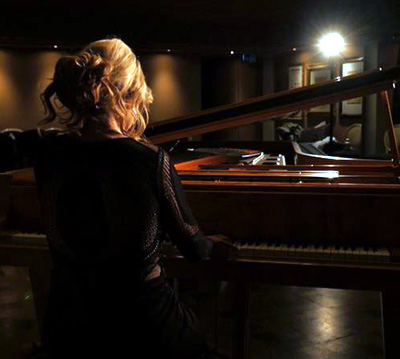 mwe3:
“Calling Earth” is track five on Signature Synchronicity.
Who else is playing with you on this version? There’s a lot
of movement on this track. Are there some electronic keyboard sounds
on that version? Are you playing any electronic keyboards on Signature
Synchronicity? Also, I don’t think you’ve described
how you came up with that song title?
mwe3:
“Calling Earth” is track five on Signature Synchronicity.
Who else is playing with you on this version? There’s a lot
of movement on this track. Are there some electronic keyboard sounds
on that version? Are you playing any electronic keyboards on Signature
Synchronicity? Also, I don’t think you’ve described
how you came up with that song title?
Fiona Joy: The only keyboard track is “Grace (Chill Version)”
The angel choir in “Calling Earth” is Noah Wilding, Borbala
Bodonyi, Rebecca Daniel and Fiona Joy (me).
There is also a little cello by Eugene Friesen. He manages to make
it sound like a radio tuning into planet Earth, so it’s hardly
recognisable as to what the instrument is exactly. A few NS Bass notes
are added by Tom Eaton. Its actually one of my favorite tracks.
I was lucky enough that an Ex NASA Senior Flight Engineer made a stunning
video
using real NASA footage to bring the song to life.
mwe3: How is the Signature Synchronicity version of
“Invisible Train” different from the Signature Solo version?
What other instrumentation do you feature on the Signature Synchronicity
version? The song seems much more ethereal sounding on this Signature
Synchronicity version.
Fiona Joy: This was the most fun to put together. It’s
storytelling in the true sense of bringing parts to life using different
instruments.
The vocal (Fiona Joy) is the smoke, the EWI (Electric Wind Instrument)
by Premik Russell Tubbs is the train whistle and the percussion by
Jeff Haynes is the train track. The piano is the train and there is
some addition of the NS bass by Tony Levin to add to give the idea
of movement.
mwe3: The chill version of “Grace” is track seven
on Signature Synchronicity. Can you compare this version with
the track two version and also the version on Signature Solo? What
about the lyrics to the Chill Version of “Grace” or are
they wordless vocals?
Fiona Joy: The lyrics are the same on both versions, actually
the song is note for note identical in the piano, but one is slow
with an emotional delivery and the chilled version is played on a
keyboard to a click track with the addition of rhythm and beatbox.
It's much faster and has a real ‘groove’.
The lyrics are:
If I could Be,
Near you I would be,
But you are far away
From here.
On the other side,
Of the rainbow,
I see you smile
Through my tears.
Chorus:
To be with Grace, To live with Grace, Always with Grace
One day I’ll find you,
Long way to go,
Sometimes I look for you,
Over the Rainbow
To be with Grace, To live with Grace, Always with Grace,
To be with Grace, To live with Grace, Always with Grace,
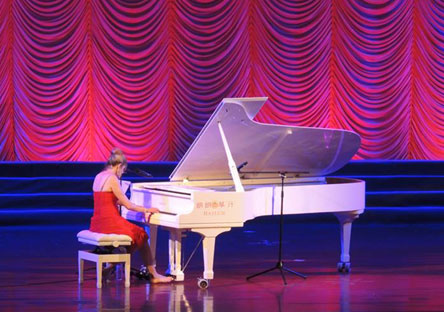 mwe3:
Track eight on Signature Synchronicity is “Signature”,
which is one of your greatest songs. Who’s playing with you on
this version? With “Signature”, did you set out to create
a kind of signature song? There’s some great string sounds on
this version. Is “Signature” one of the heavier songs on
Signature Synchronicity?
mwe3:
Track eight on Signature Synchronicity is “Signature”,
which is one of your greatest songs. Who’s playing with you on
this version? With “Signature”, did you set out to create
a kind of signature song? There’s some great string sounds on
this version. Is “Signature” one of the heavier songs on
Signature Synchronicity?
Fiona Joy: It's one of the few songs derived from improvisation
that I have recorded. It’s actually the least associated to any
story and just came from a natural place. I called it “Signature”
because the whole project was named that as a kind of thank-you to
my left hand for holding out so long. I have osteo-necrosis (bone
death) in my hand and so therein lies the magic that I still can play
any of this.
I’m flattered you think its one of my greatest... that’s
awesome. It’s really just me on piano, Will Ackerman on guitar
and Paul Jarmin on Taragato.
 mwe3:
Track nine on Signature Synchronicity is “From The Mist”
which is another kind of signature song from you? If one would suggest
a Fiona Joy signature song would it be “From The Mist”?
mwe3:
Track nine on Signature Synchronicity is “From The Mist”
which is another kind of signature song from you? If one would suggest
a Fiona Joy signature song would it be “From The Mist”?
Fiona Joy: My Father writes one main theme on all my albums.
He gave me the key theme for “From the Mist” and I took
it from there and wrote the rest of the song around it. It sounded
like a Celtic march to me and so I imagined it as such. My Father
said it was about Scotland... his father immigrated from there to
Australia. I called it a Celtic Fairie March! Part of the storytelling.
LOL
mwe3: The final track on Signature Synchronicity is
“Little Star”. There’s even some percussion on this
version. Did you have a different idea for the track on Signature
Synchronicity version compared to the Signature Solo version?
Seems like a great song to end the album with.
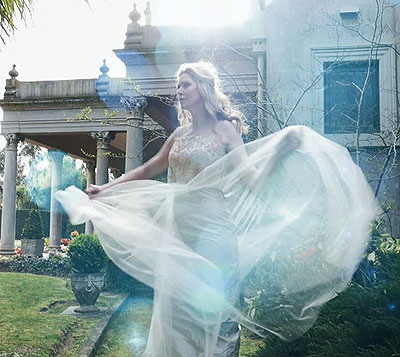 Fiona
Joy: For some strange reason, I can always hear the parts and
where the song can go, even when I’m playing it solo. It's very
impressionistic and I always wanted electric guitar, but more specifically
the magic of Marc Shulman’s electric guitar to bring the song
to life. Tony Levin helps takes the song to another place and adds
some magic with the NS bass.
Fiona
Joy: For some strange reason, I can always hear the parts and
where the song can go, even when I’m playing it solo. It's very
impressionistic and I always wanted electric guitar, but more specifically
the magic of Marc Shulman’s electric guitar to bring the song
to life. Tony Levin helps takes the song to another place and adds
some magic with the NS bass.
mwe3: Was the entire Signature Synchronicity album recorded
at Imaginary Road with Will Ackerman and Tom Eaton? It sounds like
they really captured the essence of your sound and vision. Did Will
and Tom also play on the album or were they guiding the sound, behind
the scenes so to speak in the studio?
Fiona Joy: The album was recorded in several places, but certainly
overseen by Will Ackerman and Tom Eaton. The piano was recorded in
my home by James Englund and the violin, Taragato, beat-box some vocals
and the Irish Whistle were recorded with James also in his Crash Symphony
Studios in Sydney.
The percussion, EWI, cello, bass, acoustic guitar, electric guitar,
keyboard, flugelhorn and most of the vocals as well as the mix were
all done at Imaginary Road Studios.
 I
believe the single most important ingredient in recording a good album
is the mix. That was done by Tom Eaton, and it’s a stellar and
stunning job. I probably give Tom the highest accolade in bringing
an album to life.
I
believe the single most important ingredient in recording a good album
is the mix. That was done by Tom Eaton, and it’s a stellar and
stunning job. I probably give Tom the highest accolade in bringing
an album to life.
mwe3: Is the Signature Synchronicity / Signature Solo concept
complete in your mind now? Will they ever be released or reissued
as a double CD set featuring both albums? Have you thought about what
other projects you’d like to move forward with in the not too
distant future? You 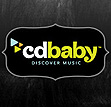 were
also talking about some live concert shows with Jeff Oster, Tom Eaton
and Lawrence Blatt at some point? Either way, the future awaits!
were
also talking about some live concert shows with Jeff Oster, Tom Eaton
and Lawrence Blatt at some point? Either way, the future awaits!
Fiona Joy: The future is two things. One: FLOW, Fiona Joy,
Lawrence Blatt, Jeff Oster and Will Ackerman. We can’t do it
without Tom Eaton, so best to add his name in there as well. We are
writing and recording an album and hoping to tour. As we are all very
busy, the touring part maybe wishful thinking, we will have to see
how 2017 pans out.
 My
other future direction is back to the roots of Signature Solo
– it’s with Cookie Marenco and Blue Coast Records in the
audiophile world where I believe there is a new market emerging for
hi definition music. I have another solo album / SACD coming out as
well as some talks for expanding into that area. Thanks for all your
support Robert, it's been lovely chatting.
My
other future direction is back to the roots of Signature Solo
– it’s with Cookie Marenco and Blue Coast Records in the
audiophile world where I believe there is a new market emerging for
hi definition music. I have another solo album / SACD coming out as
well as some talks for expanding into that area. Thanks for all your
support Robert, it's been lovely chatting.



